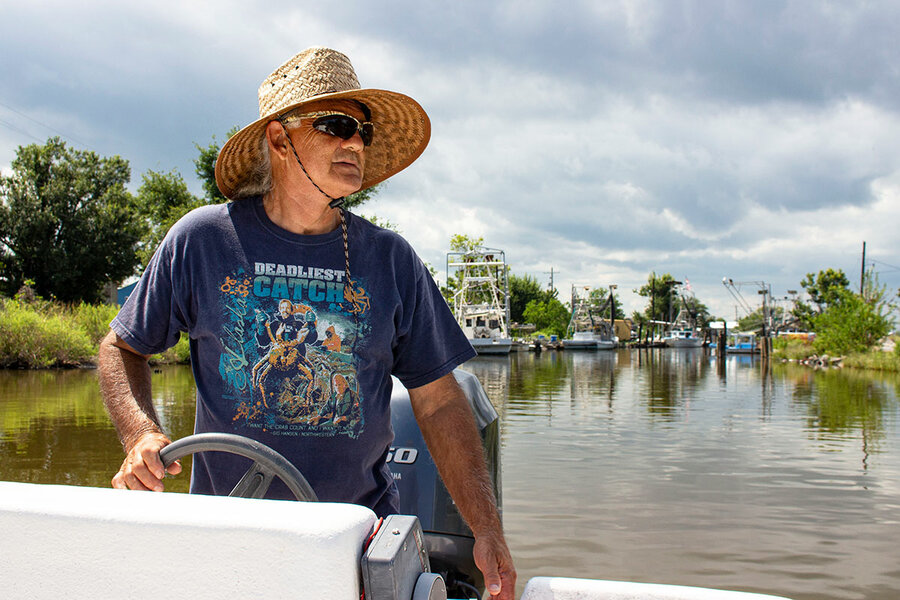Original publication by Stephanie Hanes, Whitney Eulich, Nick Roll and Dominique Soguel for csmonitor.com on 14 September 2022

Gion A. Caminada.
Emanuel Amman/Courtesy of Stephan Brenneisen
Fifteen years ago, Kyle Isacksen and his wife, Katy Chandler, lived in what most people in their home city of Reno, Nevada, would think of as a normal house. It was 1,200 square feet of drywall and two-by-fours in a neighborhood of skinny trees and other young families driving back and forth to work.
It felt, to the two of them, like a completely ridiculous arrangement.
Their lives, they sensed, lacked a connectedness – to the community, to the earth, to the high desert ecosystem in which they existed. They had just had their first child, and they couldn’t stop thinking that there was a way to live with more integrity.
“At that point, a lot of the talk was about carbon footprint,” Mr. Isacksen recalls. “But we just knew things felt off. We felt we were part of the problem, being caught up in our little rat race. We started trying to figure out how to live within our values.”
Their first move was from that 1200-square-foot tract home to a 200-square-foot straw bale cabin in a co-housing community across town. Then they went to Oregon, to apprentice with Conrad Rogue, who was at the forefront of what’s known as the natural building movement – a shift toward using Indigenous building practices and natural materials, particularly clay, to create homes and other structures.
What they learned there struck a nerve.
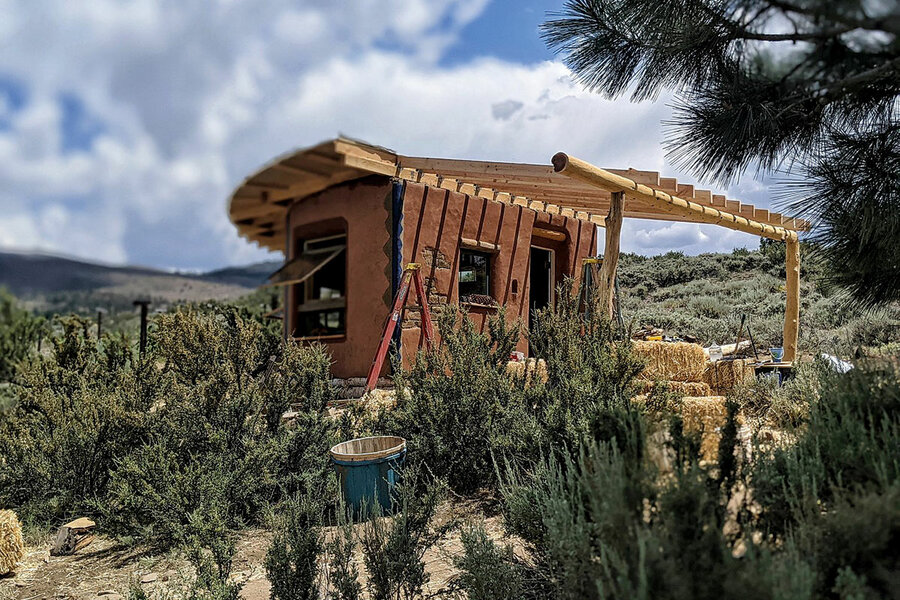
Lindsay Appel/Courtesy of Kyle Isacksen
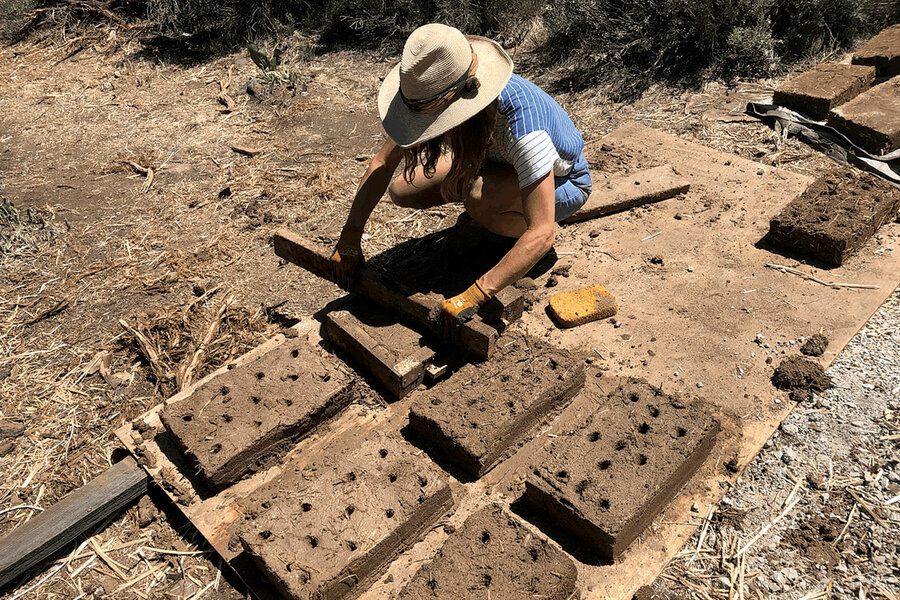
Courtesy of Kyle Isacksen
There is an integrity to building with the earth that exists, literally, at one’s doorstep, Mr. Isacksen says. Clay-based structures are also comfortable, he says, keeping far cooler in hot weather than more modern buildings, and using a fraction of the energy. And while Indigenous communities have used earthen techniques for centuries, the heat-adjusting properties of adobe and other sorts of mud-brick buildings have taken on new importance with climate change.
This summer, heat waves swept across the Northern Hemisphere, bringing record temperatures from Texas to England to Pakistan. The years 2013 to 2021 rank among the 10 warmest on record, with scientists expecting that trend to continue. In response, there has been an increased focus by entrepreneurs and policymakers on technological innovations to help humans stay cool – everything from higher-efficiency air conditioning to superwhite reflective paint to nanoparticle window films. But a growing number of architects, builders, and homeowners, from northern Africa to northern Europe, are focusing on a different approach: a return to bygone building practices that were highly attuned to place and kept spaces cool before air conditioning.
Buildings with integrity of place
“Buildings started changing at the beginning of the last century because of cheap electricity and cheap heating and cheap cooling,” says Iain Campbell, senior fellow at RMI, an energy research organization. “Before then, people would design buildings based upon climate. So if you went to, say, a building in the Middle East, it would not look like a building that is in downtown Toronto. … I understand why people are going back and saying that we need to use these natural materials. It’s the philosophy that we should be designing buildings for the climate zones they are sitting in.”
The movement is global. In Basel, Switzerland, builders are increasingly installing “green roofs” of earth and plants, a throwback to old Scandinavian sod homes. In Medellín, Colombia, policymakers have restored natural topography and greenery to their city, lowering the overall temperature dramatically. And in Dakar, Senegal, prizewinning Burkinabé architect Francis Kéré is designing with Indigenous bricks. A Kéré-designed school in Turkana, Kenya, features ventilation towers inspired by nearby termite mounds.
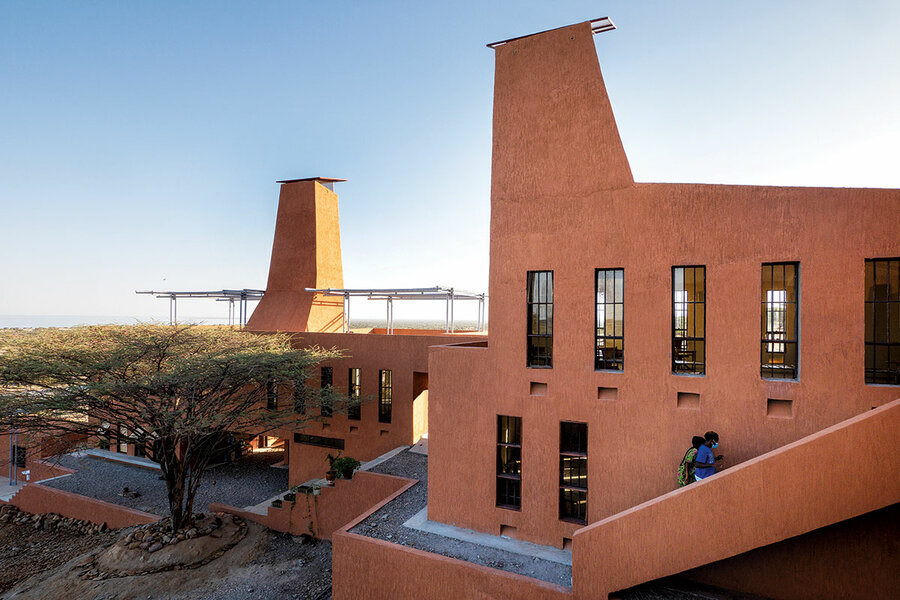
Kinan Deeb/Courtesy of Kéré Architecture
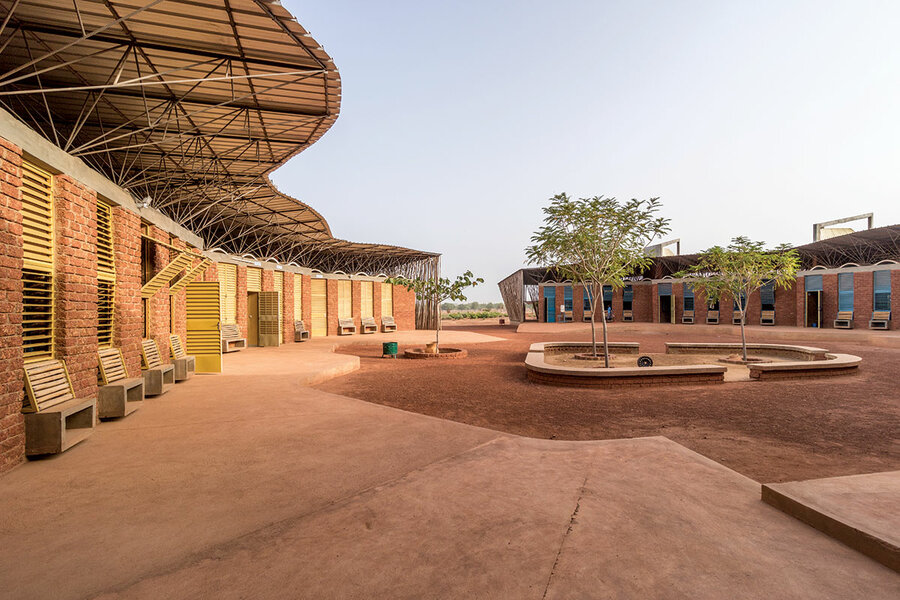
Andrea Maretto/Courtesy of Kéré Architecture
“The key word is ‘localized’ – localized with the country, with the climate, with local materials,” says Nicolas Rondet, the French architect who co-founded Worofila, a Dakar-based architectural firm that collaborates with Mr. Kéré and is behind many other new earthen brick structures in Senegal.
The goal here is not just eco-friendly buildings, many involved in traditional building say. While they certainly want homes to be climate-resilient and resource-gentle, even more so they hope to develop a larger integrity of place – one that shifts the understanding of home, of community, and of individuals’ role in an ecosystem.
Mr. Isacksen and Ms. Chandler, for their part, now offer natural building workshops back in Reno. It is one part of their Be the Change Reno nonprofit, a sustainable homestead that also involves growing food, fostering community connections, eschewing fossil fuels, and creating affordable housing. “If we’re trying to have a paradigm shift,” he says, “we need to be building our structures and our homes differently.”
The need for this paradigm shift, he and others believe, is directly connected to climate change.
Before 1900, most people were natural builders – or at least had homes intentionally created for their particular climate zones, whether that meant Spanish or Middle Eastern homes with cooling courtyards, Eastern American houses with shaded porches, or adobe-brick structures in Mexico.
But technological innovation ushered in an era of both mass construction and standardization – and by the end of the 1900s, building design had become globalized. A glass and steel office tower looked pretty much the same in Abu Dhabi as it did in Vancouver. And new homes across the United States started to look quite similar, as well.
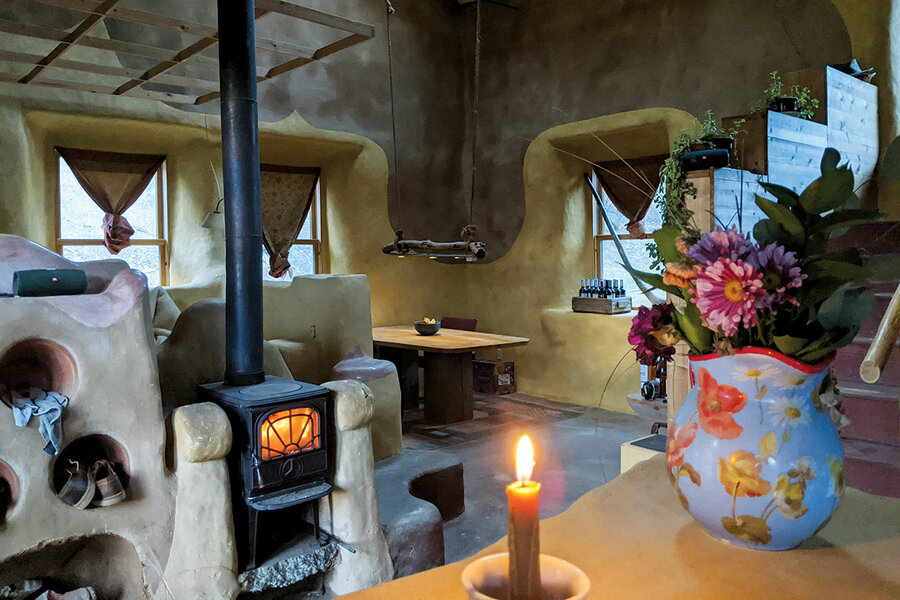
Courtesy of House Alive
The climate-construction connection
“We now live in a time where a house in Florida is built exactly the same as a house in Washington state,” says Mr. Rogue, the creator of the House Alive community in Oregon and the instructor who taught Mr. Isacksen natural building techniques. “There’s no reason for it except that we have heaters and air conditioners and trainloads of lumber going back and forth to make it possible. But I don’t think it’s serving anyone.”
Although estimates vary, experts agree that the construction industry is responsible for a hefty amount of the world’s greenhouse gas emissions – as much as 40%, according to the United Nations, if one includes building operations, such as electricity use, and the construction process itself, from making cement to transporting materials.
And most projections expect the carbon impact of buildings to grow even further – in no small part because more people will need, and will be able to buy, air conditioning.
According to the International Energy Agency, global energy demand from air conditioners is expected to triple by 2050, and the global stock of air conditioners will rise from 1.6 billion today to 5.6 billion by 2050 – a number that equates to 10 new air conditioners sold every second for the next 30 years.
Part of this is because global economic development means that more people will have the financial capability to purchase cooling devices. But it’s also because more people want – or need – air conditioning.

Iwan Baan/Courtesy of Kéré Architecture
Last year, researchers from the University of St Andrews in Scotland published a report predicting that climate change will amplify the hottest days in the tropics, with the hottest 5% of days warming 20% more than the average day – a trend that would mean dangerous heat waves in large swaths of Africa, Asia, and the Americas. Last month, the First Street Foundation, a nonprofit climate research group based in New York, released a report predicting a dramatic increase in the number of days reaching a heat index of 125 degrees in the U.S. over the next decades.
“I think there’s always been this idea that climate change is going to happen to some people somewhere, but it’s happening to everybody, everywhere now,” says Rachel Kyte, dean of The Fletcher School at Tufts University in Medford, Massachusetts, who has studied the energy implications of increased air conditioning. “If you’re rich, you’ve got more resources to throw at the problem. But you can’t self-isolate from warming.”
The problem with using air conditioning to combat the growing heat, she and others say, is that air conditioning itself adds to global warming. This is because the chemical refrigerants in most air conditioners are potent greenhouse gases, and the units guzzle electricity, which is created primarily by burning fossil fuels.
“Climate change drives higher temperatures, drives higher air conditioning use, which drives higher electricity usage,” says Scott Hinson, chief technology officer at Pecan Street, a nonpartisan energy research group. “If we provide that energy with coal, or dirty fuels, that’s a pretty vicious cycle.”
Lowering urban temperatures
Brian Dean, the head of energy efficiency and cooling for the Sustainable Energy for All nonprofit based in Vienna, says that more effective insulation, controlled ventilation, and correct positioning of the house are all architectural elements that can lower the temperature of a home without air conditioning. Tree placement and shading also can have a huge impact, he says.
“Before the invention of the air conditioner, societies used a lot of nature-based solutions,” he says.
It is an approach that urban planners are embracing – and perhaps maybe nowhere more than in Medellín.
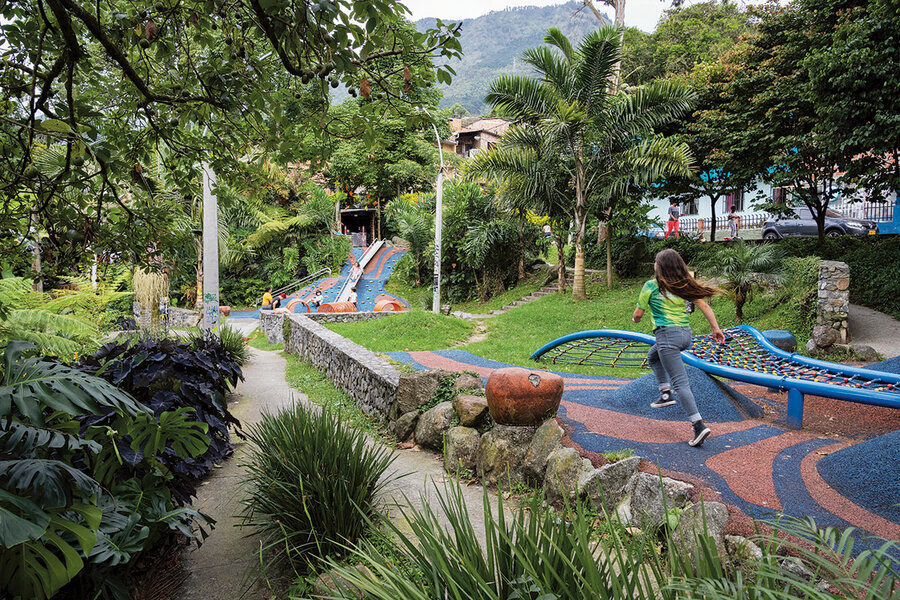
Luis Bernardo Cano
This South American city of 2.5 million, set in Colombia’s mountainous northwest, was once known primarily for its drug cartel violence. But in 2016, the year that the Colombian government signed a cease-fire agreement with the rebel guerrilla group FARC, a politician named Federico Gutiérrez took the mayor’s office of Medellín and decided to focus on climate change along with security.
He and a team of experts created the Green Corridors program – an initiative to expand greenery, replace impermeable, heat-capturing building materials, and establish a network of parks, bike paths, and other shady public spaces connecting neighborhoods across the city.
Alejandro Restrepo Montoya, an architect who served as director of strategic urban projects in Medellín at the time, says this approach was an explicit effort to restore the topography of the city, to focus on rebuilding an integrity with the natural ecosystem, rather than trying to construct over, around, or against it.
“Topography needs to be more of a protagonist in urban development and architecture,” Mr. Restrepo says. “Cities often overlook it, making errors like covering rivers to build streets. That’s not building a city. That’s disfiguring a city.”
Within three years, in those parts of Medellín where greening projects took place, average surface temperatures fell by more than 10 degrees Celsius (18 degrees Fahrenheit).
“There are so many trees, such rich nature,” says Sandra Velázquez, who runs a small beauty shop overlooking the playground in the Parque La Isla, an oasis of green near the city’s bustling center. “And on top of that, the air feels fresh.”
Medellín’s Green Corridors have caught the attention of governments across the globe, with similar projects being discussed or already in process in Guatemala, Peru, Bosnia, and elsewhere.
In Europe, a growing number of builders are taking a similar concept and applying it to individual homes.
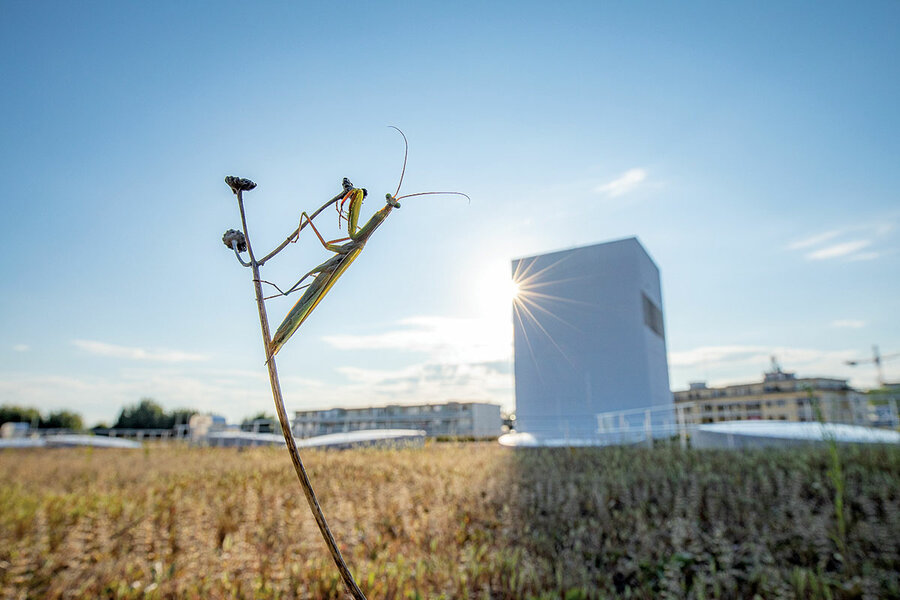
Andreas Hofstetter/Courtesy of Stephan Brenneisen
The potential of green roofs was discovered early on with the fabled hanging gardens of Babylon, one of the Seven Wonders of the World. Scandinavian countries also used to cover their roofs with sod for insulation. The concept is making inroads today in major cities from New York and London to Tehran. Also known as a living roof, a green roof covers the top of the building with vegetation planted over a waterproofing membrane.
German and Swiss cities began experimenting with green roofs in the 1980s and ’90s, mostly to save energy and promote biodiversity. But several studies showed that green roofs could also help counter the “heat island” effect – the warming of urban ecosystems that both raises temperature for residents and disrupts other natural cycles, such as rainfall.
“Cities are like heat-storing ecosystems,” says Stephan Brenneisen, an expert on urban ecology at the Zurich University of Applied Sciences. “Now climate change is making it much worse in these urban environments. This is of course now the main driver when you see the strategies of cities that want to adapt to climate change. Green roofs are in the first two or three lines of many city plans.”
The green roof offers improved insulation, lower power consumption, improved air quality, and a boost for biodiversity, offering habitats for insects and birds. But they are not risk-free. Insurance companies, for one, are often worried about the potential for leakage and damage, while building owners tend to worry about the maintenance green roofs require.
But many city planners have decided that the merits outweigh the risks. In Basel, residents contribute 5% of their energy bills toward an ecological fund that helped subsidize the green roofs. Basel has made green roofs mandatory since 2000 for new buildings with flat roofs, and since 2008 for any such building that is retrofitted. Today, nearly half of the city’s flat-roofed buildings are green. And green roofs are part of the building code in most major Swiss cities.
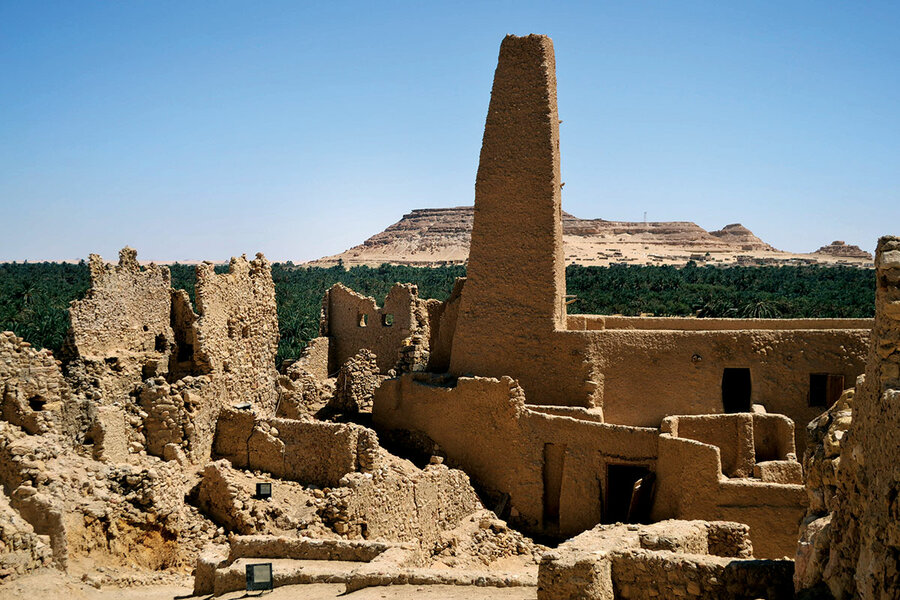
Kim Gamel/AP/File
Bricks made with salt
But in some places, there just isn’t much greenery to help with the cooling. And it is these desert environments, architects say, that perhaps give the most potent lessons for how to keep homes cool in a warming planet.
Near the border with Libya and an imposing expanse of desert lies the Egyptian oasis Siwa. Residents of Siwa have long had to battle a harsh local climate. The city’s medieval citadel was built on the oasis’s highest hill in order to protect the town from attacks from roving Arab tribes. But while the bandits might be gone, the fortress still has to fight the desert heat.
That’s made easier, though, by the architecture of the citadel and some of the old homes and buildings built nearby: They’re constructed from slabs of earth cut from the surrounding salt flats. Not only do the salt bricks provide a natural, local building material, but they also, with the right building design, help keep homes naturally cool.
Wael Al Awar, an architect based in Dubai, says he has been inspired by these salt flats, and similar ones found in the United Arab Emirates. He is now exploring methods of cement production that use magnesium oxide salt as a binding agent instead of the typical – and carbon dioxide-releasing – process of breaking down limestone.
“If you look at cement … you quickly learn the problem is in the glue, the binder,” says the Lebanese-born Mr. Awar, co-founder of the architecture firm waiwai. “It’s converting limestone to lime that really emits a lot of CO2 .”

Jacopo Salvi/Courtesy of waiwai
Rather than disturb the sabkha, or salt flats, that make up the United Arab Emirates’ wetlands, waiwai is harvesting magnesium oxide from the brine left over from the Gulf country’s plethora of desalination plants. While Mr. Awar and his colleagues have only figured out how to use this magnesium oxide salt for single-story buildings – salt corrodes steel, which is typically used for beams and reinforcements in taller load-bearing structures – they say there are lessons to be learned by this limitation.
Shorter, thick-walled structures with fewer openings are probably the most suited for the climate, they point out. Fewer windows means less sunlight pouring into a building, which “makes sense in a region where the sun is 90% blazing,” Mr. Al Awar says, and which will also “help in reducing your energy consumption.”
Wisdom in old buildings
But there is more to traditional building, he and others point out, than simply swapping out concrete and glass for salt or mud or timber, or even adding plants to the roof.
Jill Gotthelf, for instance, is a New York architect who tries to bridge the divide between historic preservation and green building – two factions of the architectural profession that have long been at odds. While she says she recognizes the potential in new technology to mitigate heat, she also sees a wisdom to old buildings.
“They have natural attributes for energy and sustainability,” she says.
Rather than trying to rehab historic structures with an eco-tech approach, she urges colleagues to pause and instead research how a building fits into its environment and its community – how historic masonry, for instance, worked as a temperature regulator; how radiant heat can be maintained but tweaked into a climate-efficient system; how porches and other outdoor spaces were not only part of one building, but often integral to a wider community.
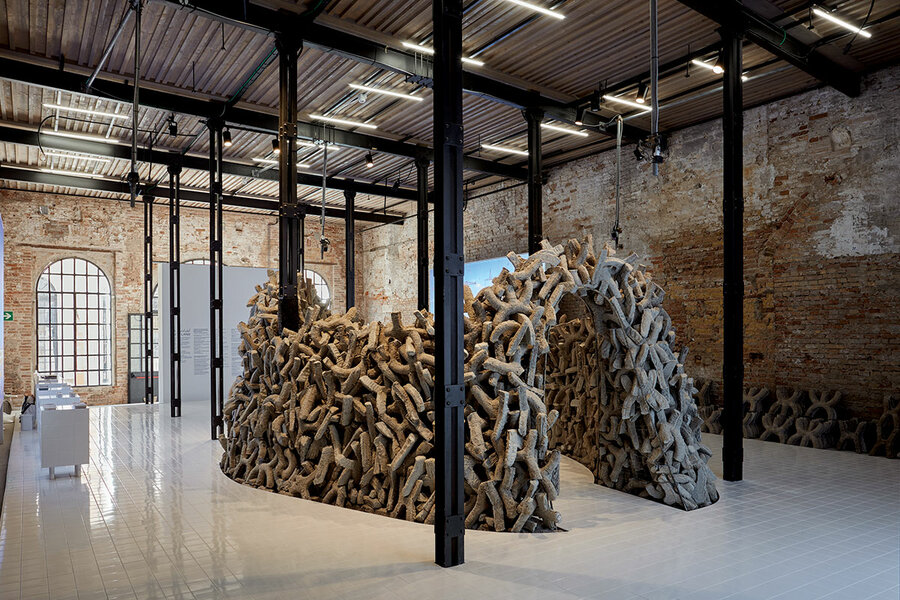
Restoring this integrity of place and design often can end up as climate-friendly as a new build with modern technology, she says.
The natural builders take this philosophy a step further. It is often countercultural to eschew what is labeled as “progress” – whether that means “more modern” cement (not brick) homes in Dakar, mini mansions in a tony American neighborhood, or the latest hyperinsulated green buildings in Europe.
But there is an integrity that comes from reclaiming one’s home – the literal place one’s life unfolds – from an ideology that has often worked against the planet, these builders say. Build with mud, and all of a sudden the latest and greatest tech seems unnecessary, says Mr. Rogue. It turns out that what’s needed for comfort and satisfaction is inexpensive, not controlled by an international supply chain, independent from fossil fuels, and part of the Earth itself.
And that, he says, can lead to a new outlook on what one actually needs and wants.
“In the climate debate, so much is focused on electric cars and the way we produce electricity,” he says. “My big worry is that if we do insulate our houses better and we all have electric cars, the next thing is going to be the demand for bigger homes or two electric cars.”
Natural building, he says, is a bridge toward thinking differently about consumption and lifestyle, which in turn makes the most climate impact.
“I teach not so much because I hope that everybody will live in a mud hut, although that would be nice,” Mr. Rogue says. “I hope that in building with earth – the lack of speed that we build with, the community aspects of it – it will have an impact on the human spirit.”



